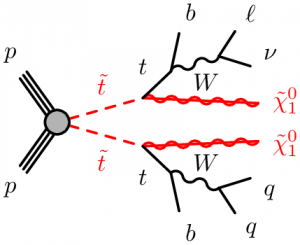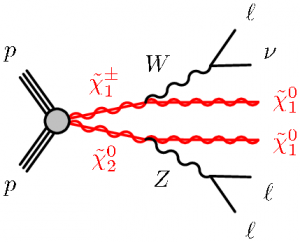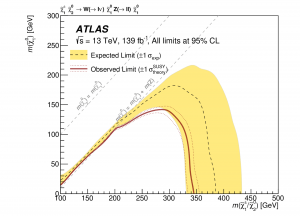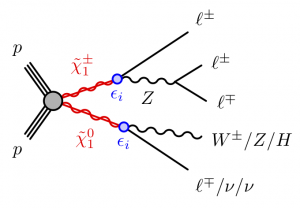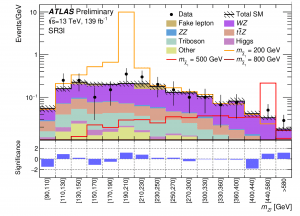Puzzles and questions in Run 2 and beyond
With the discovery of the Higgs boson in Run 1 in 2012, the standard model of particle physics is complete. However, the Higgs boson is itself an enigma with a mass of only 125 GeV. Quantum Mechanics tends to make the Higgs boson much heavier (by 14 orders of magnitude!) through the effect of radiative corrections. This “hierarchy problem” can be solved by supersymmetry, which gives every standard model particle a superpartner with a different spin. Thus the radiative corrections from the standard model particle and its superpartner should neatly cancel. Naturalness suggests that since the most significant radiative corrections are from the most massive particles in the standard model, then their superpartners should be relatively close in mass to provide a natural cancellation and thus within the reach of the LHC. The Penn ATLAS group is searching for these supersymmetric partners to the top quark, the electroweak gauge boson, and the Higgs boson.
Dark matter is another mystery. Dark matter isn’t a small effect: it causes stars to move significantly faster than expected, and there is over 5 times more dark matter than matter in the universe. There is no particle in the standard model that fits the bill. Another reason to search for supersymmetry is that some supersymmetric particles are candidates for dark matter. There is also the intriguing possibility that the Higgs boson, which couples to mass, itself could decay to dark matter. The Penn ATLAS group is searching for these invisible Higgs boson decays. Recent ATLAS Physics Briefings featuring results with contributions from the Penn group include:
- The hunt for higgsinos reaches new limits (June 2021)
- Fantastic decays and where to find them (May 2020)
- Probing dark matter with the Higgs boson (April 2020)
- Searching for natural supersymmetry with novel techniques (February 2020)
- Searching for electroweak supersymmetry (May 2019)
Supersymmetry
Discovery of supersymmetry and dark matter are top priorities for experimental particle physics in the 21st century. Our recent physics analyses on ATLAS include searches for the supersymmetric partner to the top quark (stop) and for the supersymmetric partners to the electroweak gauge and Higgs bosons (charginos and neutralinos). We consider models where the lightest supersymmetric particle (LSP) is stable (RPC = R-Parity Conserving) and models where the LSP can decay into standard model particles (RPV = R-Parity Violating).
Stop searches
Why start with stop? The strong interaction would pair produce stops at high rate, allowing sensitivity with early data in Run 2. The stop is also expected to be the lightest squark due to the large value of the top quark mass. Recent Penn scientists in the ATLAS SUSY 3rd generation subgroup include Joe Kroll, postdoc Keisuke Yoshihara and graduate students Christian Herwig (2019) and Joey Reichert (2019), and in the ATLAS SUSY RPV/LLP subgroup include Evelyn Thomson, postdoc Jeff Dandoy and graduate students Leigh Schaefer (2019), Ian Dyckes, and James Heinlein.
For RPC models, we have searched for stop in the 1-lepton channel considering stop decay to a top quark and LSP, with top quark decay to a W boson and b quark,. The 1-lepton channel has one leptonic W boson decay and one hadronic W boson decay and has a final state with one charged lepton, multiple jets including b-jets and large MET due to the neutrino and the LSPs. This topology offers good signal acceptance and background rejection in comparison to the all-hadronic or dilepton channels. The kinematics of the signature depend strongly on the mass splitting between the stop and LSP and the assumption made about the electroweakino mass spectrum.
There is an ATLAS Physics briefing on the result with the 2015-16 data, which also investigated three more complicated mass spectra as benchmarks, an innovation led by Penn. For the wino NLSP model, the stop can decay to a chargino and a b quark. As well as contributing to many aspects of the analysis, the study of a significant systematic uncertainty on the background models led to a separate paper describing a measurement of the interference effects between top-quark pair production and associated production of a single top quark and a W boson. For the higgsino LSP benchmark, with small mass splitting between the three lowest electroweakinos, the signature is characterized by low-momentum leptons from W and Z boson decays far off mass-shell. Penn’s involvement in electron identification was important to extend the calibration of electrons to lower thresholds.
There is an ATLAS Physics briefing on new results released in February 2020 with the full Run 2 dataset of 139/fb. These include optimized analyses for compressed models with small mass splitting between the stop and the LSP. The 3-body analysis, where the mass splitting is smaller than the top quark mass (173 GeV), was designed by employing machine learning technique (recurrent neural network) to improve the experimental sensitivity. The 4-body analysis, where the mass splitting is smaller than the W boson mass (80 GeV), the sensitivity is being improved by extending b-jet identification to lower thresholds.
- Search for new phenomena with top quark pairs in final states with one lepton, jets, and missing transverse momentum (139 /fb)
- Search for direct top squark pair production in the 3-body decay mode with a final state containing one lepton, jets, and missing transverse momentum (139 /fb)
- Probing the quantum interference between singly and doubly resonant top-quark production (PRL)
- Search for top-squark pair production in final states with one lepton, jets, and missing transverse momentum (36/fb)
- Search for top squarks in final states with one isolated lepton, jets, and missing transverse momentum (3.2/fb)
For RPV, in the B-L model we have studied stop as a possible LSP with theorists at Penn. We consider stop decay to a b quark and charged lepton. In contrast to the RPC searches, there is no significant missing transverse momentum. The topology of two oppositely charged leptons and two b-jets offers excellent signal acceptance and background rejection due to the presence of two massive resonances formed from a charged lepton and a b-jet. The asymmetry between the masses of the two lepton b-jet resonances is a key discriminating variable between signal and background. The flavor of the charged lepton depends on the RPV coupling, which depends on the neutrino masses and the neutrino mass hierarchy, and a large phase space in the branching ratio plane is available. The branching ratio to the final state may be as large as 90% in the inverted mass hierarchy and the branching ratio to the
may be as large as 100% in the normal mass hierarchy. Our search covers most of this branching ratio phase space by considering final states with electrons and muons (
) with some sensitivity to taus through their leptonic decays. In contrast to exotics searches for pair production of leptoquarks, it is not constrained to consider only final states within the same generation (at the corners of the phase space triangle). What’s next? A paper is in preparation to extend the search to higher values of the stop mass, where identification of very high
b-jets and muons is critical, with the full Run 2 data set.
Theoretical
- Spontaneous R-Parity Breaking, Stop LSP Decays and the Neutrino Mass Hierarchy
- LSP Squark Decays at the LHC and the Neutrino Mass Hierarchy
Experimental search
- A search for B−L R-parity-violating top squarks (36/fb)
- A search for B−L R-parity-violating top squarks (20/fb at 8 TeV)
Electroweakino searches
Electroweakinos are linear combinations of the supersymmetric partners to the electroweak and Higgs bosons. There are four neutral neutralinos and two positively and two negatively charged charginos. The electroweak interaction would produce charginos and neutralinos at low rates, so the experimental constraints on the masses of these particles are still relatively low. Therefore searches become more and more interesting as we continue to analyze Run 2 data and look forward to collecting Run 3 data from 2021-24 and much more at the High-Luminosity LHC. Recent Penn scientists in the ATLAS SUSY Electroweak subgroup include Elliot Lipeles, Joe Kroll, Evelyn Thomson, Brig Williams, postdocs Jeff Dandoy (convener), Shion Chen, Joana Miguens Machado (former convener), and graduate students Joey Reichert (2019), Elodie Resseguie (2019), Christian Herwig (2019), Leigh Schaefer (2019), Rachael Creager (2019), Lucas Flores, Ian Dyckes, Joe Mullin, Sicong Lu, and Luis Gutierrez Zagazeta.
For RPC models, the stable LSP is the lightest neutralino. The experimental signature depends on the mass splitting between the next-to-lightest supersymmetric particle (NLSP) and the LSP. If the mass splitting is above the electroweak scale, then the W and Z bosons from the NLSP decay will be on-shell and will decay to energetic leptons. If the mass splitting is compressed (small), then the W and Z bosons from the NLSP decay will be off-shell and the leptons will be much softer. One of the toughest backgrounds to estimate is that from hadronic particles that are mis-identified as leptons. This allows a physics process with a large cross section like Z+jets to be promoted into the 3 lepton category, and a WZ to be promoted into the 4 lepton category. Although the background is small, so is the signal that we are looking for! Penn has built up significant expertise in the estimate of this type of “fake” lepton background that is essential for the searches with soft leptons.
The research of Penn scientists in Run 2 started with a measurement of the dominant background from WZ boson pair-production, then results with 36/fb and 139/fb for large and compressed mass splittings, featured in an ATLAS Physics Briefing Searching for Electroweak SUSY. We also reinterpreted a disappearing track analysis in terms of higgsinos. In 2021, another ATLAS Physics Briefing “The hunt for higgsinos reaches new limits” highlights two new analyses looking for supersymmetric partners to the Higgs boson. We explored a new channel in the all-hadronic search where the W and Z bosons decay to quarks, and updated results for the 3 lepton search, including developing a machine learning algorithm for electron and muon selection to improve efficiency and reduce backgrounds.
- Search for charginos and neutralinos in final states with two boosted hadronically decaying bosons and missing transverse momentum (139/fb)
- Search for chargino-neutralino pair production in final states with three leptons and missing transverse momentum (139 /fb)
- Search for chargino-neutralino production with mass splittings near the electroweak scale in three-lepton final states (139/fb)
- Searches for electroweak production of supersymmetric particles with compressed mass spectra (139/fb)
- Search for electroweak production of supersymmetric particles in final states with two or three leptons (36/fb)
- Search for electroweak production of supersymmetric states in scenarios with compressed mass spectra (36/fb)
- Search for direct pair production of higgsinos by the reinterpretation of the disappearing track analysis (36 /fb)
- Measurement of the WZ boson pair-production cross section (3.2/fb)
For RPV, in the B-L model we have studied several possible LSPs and their decays with theorists at Penn. A search featured in an ATLAS Physics briefing in May 2020 (Fantastic decays and where to find them) has been performed for the case where the LSP and NLSP are winos, where the mass splitting is predicted to be so tiny that both the NLSP and LSP will have RPV decays to standard model particles. Here the LSP and NLSP can be the lightest chargino and neutralino or vice versa. In this case, the tiny mass splitting is very helpful since it opens up three possible production channels with approximately the same cross section: chargino-pair production and positive chargino-neutralino and negative chargino-neutralino production. The search looked for a spectacular trilepton resonance when at least one chargino decays to a Z boson and a lepton, and the Z boson decays to leptons. We considered final states with 3 leptons, 4 leptons, and 4 leptons with a di-jet mass consistent with a W, Z, or Higgs boson. Limits were set in the plane of the branching fraction of the wino to Zl and the wino mass.
What’s next? We plan to explore a new signature where the chargino decays predominantly to a Higgs boson and a lepton, and the Higgs decays to b quarks. In principle this is a “4b + lepton(s)” signature, where the standard model search for diHiggs production (“4b and no leptons) is a hot topic. We may adapt the RPV stop search from 2 leptons and 2 b- jets to this new scenario with 2 leptons and possibly 2 large jets from boosted Higgs decay to b quarks. Further, for the highly preferred case of a bino LSP, the existing RPC SUSY searches should be sensitive in the case of prompt LSP decays with neutrinos (eg and
) and very long-lived LSPs. We are interested in reinterpreting these signatures and exploring the feasibility of unconventional signatures, including prompt decays to a W boson and a charged lepton, or long-lived decays to displaced leptons and jets.
- Theoretical
- Experimental search
Higgs and Electroweak Symmetry Breaking
The exciting discovery of the Higgs boson in 2012 solved the key mystery of electroweak symmetry breaking in the standard model. Penn scientists contributed to the three main discovery channels (diphoton, WW and ZZ channels) and to the ditau channel. As well as the physics analyses, significant improvements were made to photon identification, electron identification, tau identification, and resolution on missing transverse momentum (MET). Since then, we’ve been measuring the properties of the Higgs boson and searching for Higgs decays to particles beyond the standard model.
- Combined measurement of differential and total cross sections in the diphoton and ZZ channels (36/fb)
- Search for exotic decays of the Higgs boson to at least one photon and missing transverse momentum (79/fb)
The search for invisible decays of a Higgs boson to dark matter is particularly interesting, with several sets of results on this topic finding new challenges to tackle each time. A conference note was released in April 2020 with the full Run 2 dataset, and excludes the decay of the Higgs boson to dark matter at branching fractions of above 13% at 95% CL and was featured in an ATLAS news item and Physics Briefing (Probing dark matter with the Higgs boson). Recent Penn scientists include Elliot Lipeles, Brig Williams, Bijan Haney (2018), Khilesh Mistry (2019), Ben Rosser, Riley Xu, and Avi Kahn.
- Search for invisible Higgs boson decays with vector boson fusion signatures (139/fb)
- Search for invisible Higgs boson decays in vector boson fusion (36/fb)
- Search for invisible decays of a Higgs boson using vector-boson fusion (20/fb)
- Search for invisible decays of a Higgs boson produced in association with a Z boson (20/fb)
Penn scientists have also contributed to the observation of W boson scattering, which is a fundamental probe of electroweak theory in the standard model. Vector Boson Scattering (VBS) processes involve quartic gauge-boson self-interactions, and the s– and t-channel exchanges of a gauge or Higgs boson. The Higgs boson regularizes the VBS amplitude by canceling out the divergences arising from longitudinally polarized vector bosons at high energy. These cancellations depend on the gauge structure of the theory and are exact in the standard model (SM) . Recent Penn scientists include Joe Kroll and Will DiClemente (2019).




